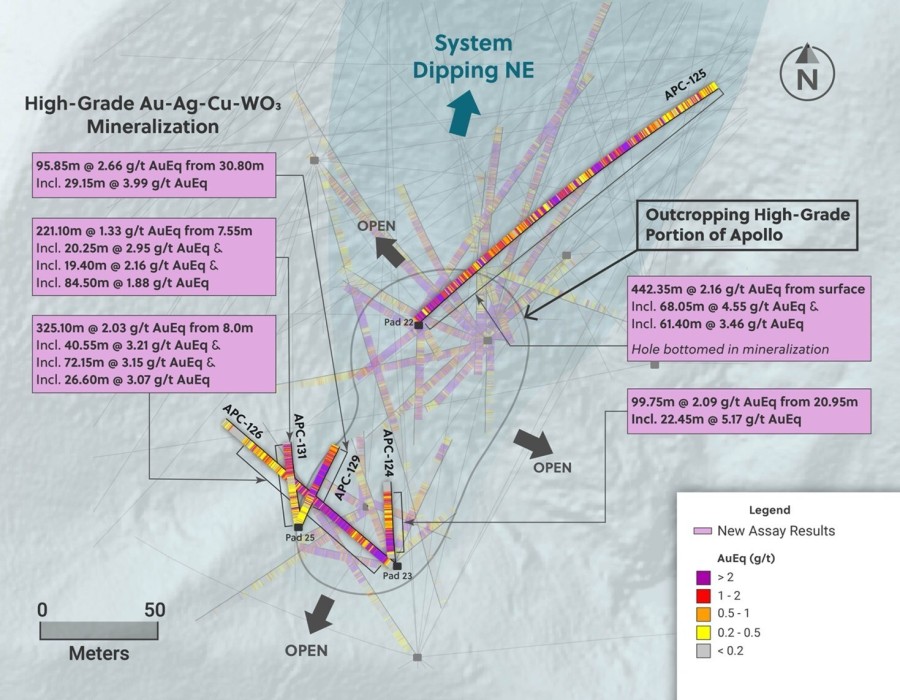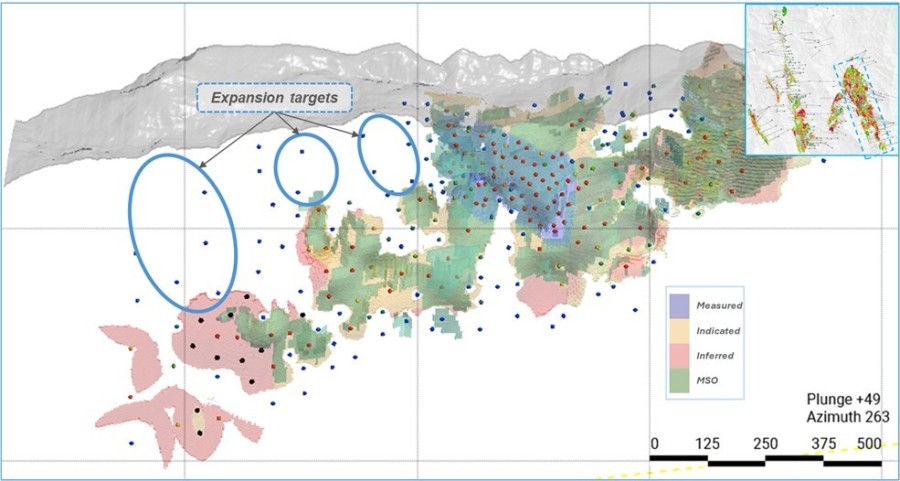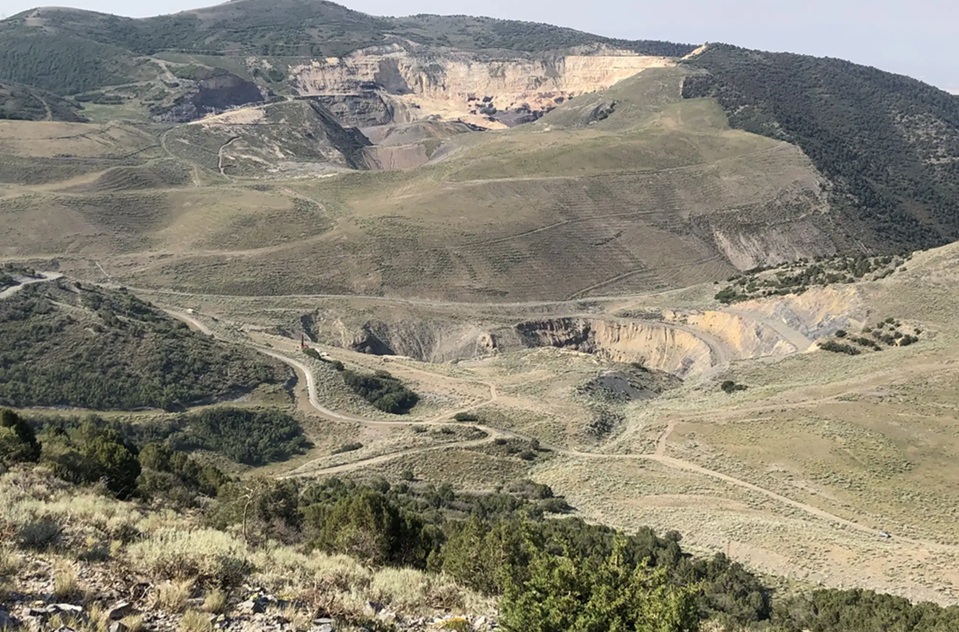VANCOUVER, British Columbia, Oct. 17, 2017 (GLOBE NEWSWIRE) -- Novo Resources Corp. (“Novo” or the “Company”) (TSX-V:NVO) (OTCQX:NSRPF) is pleased to announce that recent diamond core drilling supports strong continuity of targeted gold-bearing conglomerates at the Purdy’s Reward tenement, a farm-in and joint venture Novo has with ASX-listed Artemis Resources Limited and part of Novo’s greater Karratha gold project, Western Australia. Over the past two weeks, twelve diamond core holes have been completed in an east-west oriented area measuring approximately 400x200 m (see Figure 1 below). Targeted conglomerate strata have been intercepted in all holes (see Figure 2 below) and remain open into the greater basin to the southeast. Strata dip at very shallow angles, generally less than 10 degrees.
Figure 1. Plan map showing completed and planned diamond core drilling at the Purdy’s Reward prospect. The location of two cross sections shown in Figure 2 is also provided.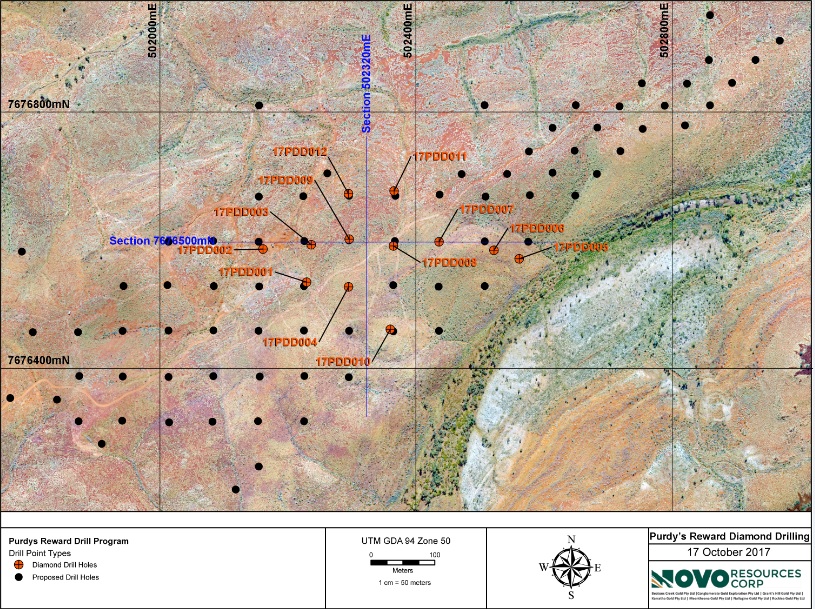
Figure 2. Two cross sections illustrating geology encountered by recent diamond core holes at the Purdy’s Reward prospect. Targeted conglomerates rest unconformably on top of basement metamorphic and igneous rocks and conformably beneath the Mt. Roe Basalt. Lateral continuity of the conglomerate package is excellent.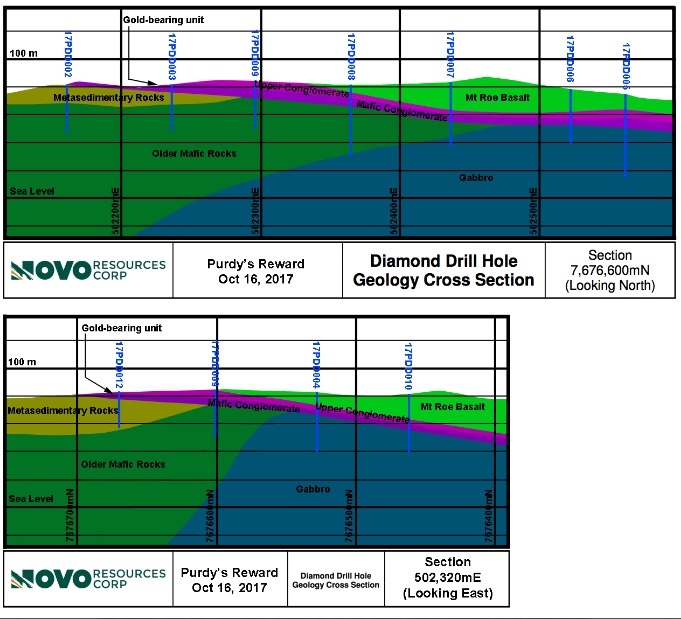
As discussed in the Company’s news release dated August 31, 2017, Novo is undertaking a two-pronged approach to drilling at Karratha. Scout diamond core drill holes will help allow initial assessment of the depth and thickness of targeted gold-bearing conglomerates. Once target depth and thickness have been determined, large diameter percussion holes (17.5” diameter) will be drilled to collect bulk samples, something necessary given the nuggety nature of gold mineralization. Novo is currently drilling on a 50 m grid at Purdy’s Reward.
Diamond core has provided invaluable information about the gold-bearing conglomerate strata sandwiched between >3.0 billion year old metamorphic and intrusive rocks and the 2.78 billion year old Mt. Roe Basalt, considered the basal member of the Fortescue Group (see Figure 3 below). The Mt. Roe Basalt appears to rest conformably on top of the conglomerate package suggesting it is of similar age to underlying conglomerates. Basalt flows commonly display pillowed textures and indicating they were extruded into a subaqueous environment, likely a shallow marine setting such as a shoreline. Conglomerate horizons appear to be sheet-like rather than channelized and, like the basalt, are interpreted to have been deposited in a shallow shoreline environment. Sandstone horizons thought to be tidal flat deposits (see Figure 4 below) are interbedded with conglomerate horizons.
Figure 3. Uncut core from diamond drill hole 17PDD007. The interval begins at 9.55 m and ends at 28.91 m. The targeted conglomerate package falls between 15.4 and 24.9 m. Overlying Mt. Roe Basalt flows display pillow textures and autobrecciation indicating these were extruded into a subaqueous setting. Interbedded conglomerates and sandstone are interpreted to have been deposited in a shallow, shoreline setting.
Figure 4. Outcropping sandstone bed displaying symmetrical ripples. Such ripples form in a shallow marine environment such as a tidal flat or bay. This outcrop occurs near the top of the conglomerate sequence in an area near current diamond drilling at Purdy’s Reward.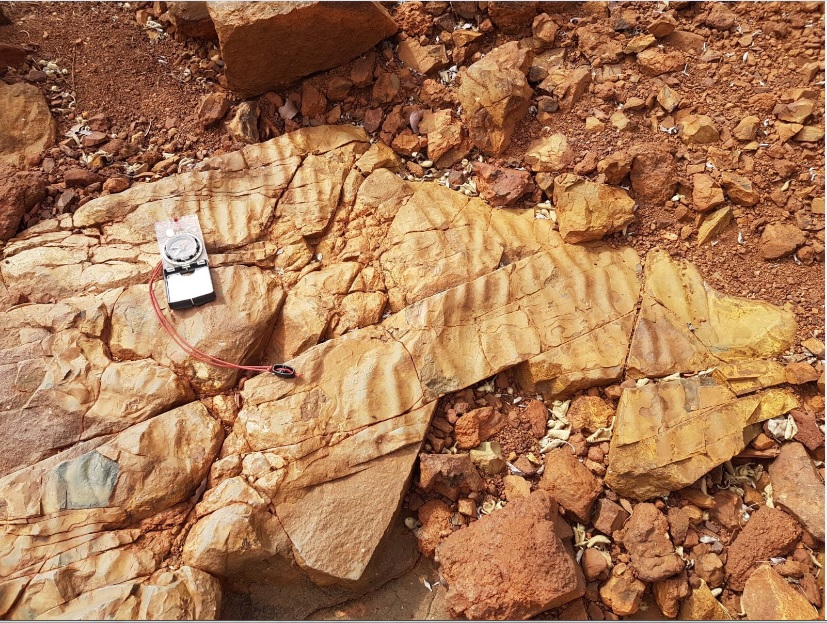
Rounded to angular clasts of mafic volcanic and intrusive rocks dominated most conglomerate horizons. A slight distinction is made between a lower sequence that is nearly devoid of quartz and an upper sequence that bears up to 10% rounded white quartz clasts. Novo personnel have noted at surface that while the entire conglomerate sequence has been subject metal detecting activity, most gold appears to be derived from the lower, mafic clast-rich conglomerate sequence. The entire conglomerate sequence ranges from around 4 to 15 meters in true thickness within the area that has been drilled.
Water worn, detrital pyrite is common between larger rock clasts (see Figure 5 below). Such pyrite is common in gold-bearing conglomerates at Novo’s Beatons Creek conglomerate-hosted gold project approximately 350 km east of Karratha and in many gold deposits in the Witwatersrand basin of South Africa. The presence of pyrite serves as an indicator that no oxygen was present in Earth’s atmosphere at the time of deposition for had oxygen been present, it would have readily oxidized to rust.
Figure 5. Sawn diamond core from 12.9 m in hole 17PDD008. Detrital pyrite (“buckshot” pyrite) can be seen in the matrix between clasts. Such pyrite is common at Novo’s Beatons Creek project approximately 350 km east of Karratha and in many gold deposits in the Witwatersrand basin, South Africa.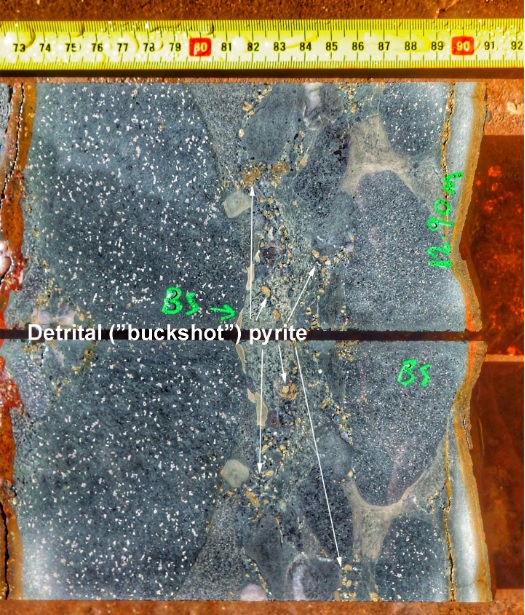
A particularly interesting pyrite clast was observed within a mafic clast-rich conglomerate at 28.9 m depth in hole 17PDD007 (see Figure 6 below). Very fine filaments of pyrite intergrown with silica are interpreted to be the fossil remains of a stromatolite, a type of bacterial mound that grows in shallow water, especially along shorelines and bays.
Figure 6. Clast of possible fossilized stromatolite, a type of microbial mound that lives in shallow water environments. The stromatolite has been replaced by fine grained pyrite.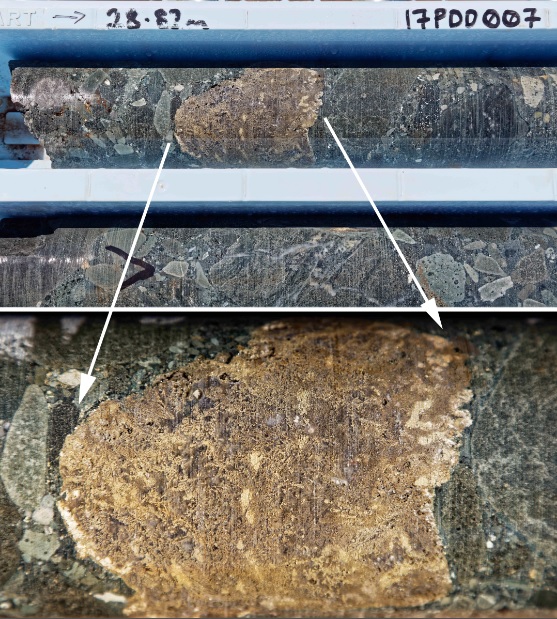
Novo plans to accelerate diamond core drilling at Purdy’s with a second drill that should be on site within two days. Large diameter percussion drilling is anticipated to commence within a week. Recently completed diamond cores holes will be twinned to obtain bulk sample material for assay.
“We are pleased to see strong continuity of the gold-bearing conglomerate unit at Purdy’s Reward,” commented Dr. Quinton Hennigh, President, Chairman and a director of Novo Resources Corp. “Diamond drill core is providing us our most complete picture to date of this remarkable deposit. Gold-bearing conglomerates were clearly deposited in a shallow marine setting, an environment that can potentially persist over large lateral extents. These are not erratic, localized river-lain alluvial deposits. We eagerly await ramping up our core drilling efforts and commencement of our large diameter percussion drill program.”
Karratha Gold Project
Gold mineralization at Karratha is hosted by a sequence of conglomerate beds, fossil gravel horizons, ranging from a few meters to approximately 20 meters thick comprising the base of a much thicker package of sedimentary and volcanic rocks called the Fortescue Group. Rocks of the Fortescue Group were deposited between 2.78 and 2.63 years ago upon 3.0-3.7 billion year old igneous and metamorphic rocks that make up the Pilbara craton, an ancient piece of Earth’s crust.
Over the past year, local metal detectorists have excavated gold nuggets originating from weathered conglomerate along an eight-kilometer, southwest-trending corridor between the Purdy’s Reward prospect (please refer to the Company’s news releases dated May 26 and August 15, 2017) and Comet Well (please refer to the Company’s news releases dated April 11, June 26, and August 3, 2017). These gold-bearing conglomerates dip gently southeastward under cover at angles of between 2 and 20 degrees. The Company secured 100% control over approximately 7,000 sq km in areas along strike and down dip from Purdy’s Reward and Comet Well through aggressive staking earlier this year. Novo believes that these gold-bearing conglomerates may underlie significant areas within the greater Fortescue basin.
In the Company’s news release dated July 12, 2017, Novo discussed discovery of gold nuggets in a bulk sample collected from a trench at the Purdy’s Reward prospect. Metallurgical test work conducted on this sample was discussed in the Company’s news release issued August 8, 2017. The weighted average grade of two splits of this bulk sample was 67.08 gpt Au. Approximately 82% of the gold in this sample was determined to be coarse, mainly nuggets displaying several interesting characteristics. These are commonly flattened with rounded edges giving them an appearance similar to watermelon seeds. Most are coarse, +2 mm and are not attached to quartz or other minerals. Gold is of high purity, +96%, much higher than the gold content of nuggets derived from basement-hosted lode gold deposits from the Pilbara region that commonly display purities of 70-90%. Nuggets display crenulated surfaces thought derived from burial and compaction within a sandy matrix.
In addition to coarse gold, this metallurgical test confirmed a significant fine-grained gold component is present in these conglomerates. Such fine gold, if it is indeed disseminated throughout the conglomerates, could prove important to help evaluate grade and continuity of this deposit.
Dr. Quinton Hennigh, the Company’s, President and Chairman and a Qualified Person as defined by National Instrument 43-101, has approved the technical contents of this news release.
About Novo Resources Corp.
Novo’s focus is to explore and develop gold projects in the Pilbara region of Western Australia, and Novo has built up a significant land package covering approximately 12,000 sq km. Novo also controls a 100% interest in approximately 2 sq km covering much of the Tuscarora Au-Ag vein district, Nevada.


